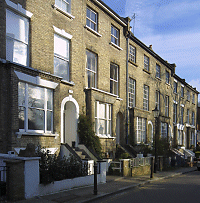|
A mini-village in north Hampstead, with more to it than most maps suggest. This part of Hampstead Heath was originally known
as Gangmoor, and later as Hatches (or Hatchett’s) Bottom, after an early-18th-century cottager. The Hampstead Water
Co. created a pond here in 1777, which drained enough of the formerly malarial marsh to allow houses to be built. For much
of its early existence, Hatches Bottom was not regarded as a picturesque village but as an intrusive presence on the heath.
The essayist Leigh Hunt lived here from 1816 to 1818 and regularly hosted meetings of writers and poets, who included Shelley,
Keats and Byron. In 1851 the village had 57 adults and 30 children crammed into 18 houses. With the opening of the Hampstead
Junction Railway in 1860, day-trippers began to swarm here in summertime and the Hampstead Heath Hotel and Vale of Health
tavern were built, neither of which has survived. In 1877 the Athenaeum Club opened in a chapel-like building, later becoming
an Anglo-German society with over a thousand members. By 1890 the village had 53 houses. Those who wished to attract visitors
invented and propagated the ‘Vale of Health’ name, although this did not fully supplant the older identity until
the mid 20th century. The village now consists mainly of attractive villas and cottages, often separated by narrow passageways,
together with two small blocks of private flats. Residents formed the Vale of Health Society in 1973 to resist inappropriate
development and marked its 25th anniversary by founding Heath Hands, the first volunteer corps dedicated to Hampstead
Heath.
Former residents of the vale include Leigh Hunt, DH Lawrence, Stella Gibbons, Compton Mackenzie, Edgar Wallace and the Nobel prize-winning Indian poet Rabindranath Tagore.
 |

